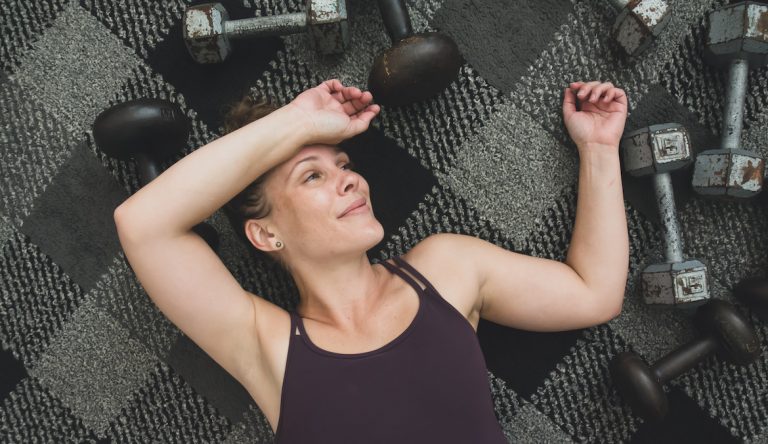
[ad_1]
Your post-workout routine shouldn’t feel harder than the workout itself. But making time for everything we’re told to do after intense exercise can be overwhelming, especially when it all—refueling, stretching, getting out of sweaty clothes—feels urgent.
As it turns out, your post-workout routine can mostly be whatever works best for you. And it can probably be much quicker than you’d think.
Start your post-workout routine during your workout
Just like you probably put some forethought into your workout—mapping out your intervals, or planning your reps and sets—thinking about your post-workout routine in advance can make it that much easier.
One way to do this: Make sure you’re properly hydrating and fueling during (and prior to) your workout, so you’re not so depleted when you’re done that you need to eat or drink urgently. Yes, it can be annoying to carry hydration or pause your HIIT session for a sip, but if you’re working out in warm weather, or for longer than an hour, you probably need to.
Another strategy: If you’re going to be driving home after a workout, have hydration and a snack ready in the car, suggests Jason Machowsky, RD, CSSD, ACSM-CEP, CSCS, a sports dietitian and exercise physiologist at the Hospital for Special Surgery’s Tisch Sports Performance Center.
And don’t forget to account for the time it takes to cool down when planning your workout in the first place, says Heather A. Milton, MS, RCEP, CSCS, an exercise physiologist supervisor at NYU Langone Sports Performance Center. She says she often sees runners who have an hour-long lunch break try to maximize miles by running for a full hour, and not leaving themselves time for anything else.
“All of the things surrounding the run are as important as the run itself,” she says. “It’s not a benefit to ignore those things for two more minutes of running.”
Prioritize the cooldown
Think of the cooldown as the last five minutes of your workout, and it won’t feel like just another thing to get done after you’re done exercising.
Milton’s recommendation for runners is to plan to end your run a few minutes away from your home or final destination, and use those last few blocks to transition from running to jogging to walking and allow your heart rate to come down, “so that you’re walking back into the building without being a sweaty, out-of-breath mess,” she says. Cyclists can take a similar gradual slow-down approach. And if you’re strength-training in the gym, you can set aside those last few minutes for something lower-intensity, like mobility work.
What your cooldown looks like is actually less important than getting it done, says Milton—just take a few minutes at the end of your workout to transition from a high-intensity state to a resting state.
“We don’t want to have our body be in that heightened amount of intensity for a prolonged period of time,” she says. “When you exercise, your sympathetic nervous system starts to increase—that increases your heart rate, your breathing, blood perfusion to the working muscles, and your metabolism. Those are all good things to happen when you are exercising, but you want to transition away from that and into a rest state to start to aid in recovery when you’re done.”
Stopping exercise without this transition could mean the redistribution of blood flow doesn’t occur as gradually, she says, which can cause fluctuations in blood pressure. And if you don’t cool down, you’re more likely to have a higher resting heart rate and higher blood pressure for longer, which likely means you won’t be as recovered for your next session.
But don’t let yourself get cold
If you find that your sweaty workout clothes are giving you the chills once you stop moving, make it a priority to change and shower before you do anything else, says Milton. Otherwise, you could make yourself more vulnerable to catching a cold, since our immune function already dips slightly after high-intensity exercise.
Refuel when you need to
As long as you’ve eaten within the past four or five hours, you probably don’t need to rush to refuel after your workout. In fact, Milton says that she doesn’t advise eating right away, since blood flow will still be going to the working muscles rather than the digestive system.
“Cooling down and starting to receive that blood flow back to your whole body again is important to do first,” she says.
This advice might come as a surprise, since we often hear experts saying we need to eat in that crucial 30-minute window after exercise for optimal recovery. But the truth is that most of us aren’t trying to so go hard in back-to-back workouts that we really need to max out those refueling benefits.
One exception: If you do have another tough workout planned for the same day, Machowsky says you’ll want to eat soon after to maximize absorption. Otherwise, eating a balance of carbohydrates and protein within two hours of your workout should do the trick—no need to suck down a shower smoothie (unless you find that fun).
And stretch whenever you can
Milton says that your cooldown doesn’t need to include stretching at all, and that according to both the Centers for Disease Control and Prevention and the American College of Sports Medicine, we really only need to stretch twice a week. In theory, this could happen at any point during your day—not necessarily right after your workout.
But, she says, if you tend to get tight after a hard workout—and especially if you’re going to be sitting at a desk for the rest of your day—you may want to go ahead and get in a short stretch and foam roll. (Plus, points out Machowsky, you may forget to do it otherwise.) If you don’t have time, don’t fret—there are still plenty of benefits to stretching later on while you’re watching TV, or before bed.
Try this stretch series whenever you can fit it in:
[ad_2]
Source link